Abstract
Machine ethics has been proposed as a new discipline at the intersection of ethics and computer science, aimed at investigating computational models of ethical principles to be embedded into the autonomous software and robotic systems to come. This work provides a view on the current research on autonomous systems and aims to show that classic ethics guiding human researchers is what is really needed.
Access this chapter
Tax calculation will be finalised at checkout
Purchases are for personal use only
Similar content being viewed by others
Notes
- 1.
This would roughly equate to putting a robot in a cage.
- 2.
I wrote ‘originally’ because some recent research endeavors have the aim to recreate the complexity of the animal and human brain in simulated or embodied form, so that systems are built without a specific task in the mind of the researchers, but rather a higher-level scientific objective that does not directly translate into a control program (Adee 2010; Mims 2011; Hsu 2014).
- 3.
There might be readers contending that by not killing the potential organ donor the machine would indeed do harm to a human (five, to be precise), and that having such a negative goal would cause a contradiction in the machine’s logical circuits. There is indeed an ethical problem, but this does not constitute a call for machine ethics. Indeed, it may be the opposite: do we really wanna endow machines with faulty theories?
- 4.
The adverb strictly refers to the context of ethics. The Google car is undoubtedly one of the most brilliant accomplishments in engineering in the recent years.
References
Adee, S. (2010). Cat-brain fever. IEEE Spectrum, 47(1), 16–17.
Anderson, M., & Anderson, S. L. (Eds.). (2006). IEEE Intelligent Systems: Machine Ethics, 21(4).
Anderson, M., & Anderson, S. L. (2007). Machine ethics: Creating an ethical intelligent agent. AI Magazine, 28(4), 15–26.
Anderson, M., Anderson, S. L., & Armen, C. (2006). An approach to computing ethics. IEEE Intelligent Systems, 21(4), 56–63.
Andreopoulos, A., Taba, B., Cassidy, A. S., Alvarez-Icaza, R., Flickner, M. D., Risk, W. P., Amir, A., Merolla, P. A., Arthur, J. V., Berg, D. J., Kusnitz, J. A., Datta, P., Esser, S. K., Appuswamy, R., Barch, D. R., & Modha, D. S. (2015). Visual saliency on networks of neurosynaptic cores. IBM Journal of Research and Development, 59(2/3), 1–16.
ANSI/RIA. (2013). R15.06-2012 American National Standard for Industrial Robots and Robot Systems—Safety Requirements. Technical report, Robotic Industries Association.
Arkin, R. (2008). Governing lethal behavior: Embedding ethics in a hybrid deliberative/reactive robot architecture. Technical Report GIT-GVU-07-11, Georgia Institute of Technology.
Asimov, I. (1950). I, Robot. New York: Gnome Press.
Balaguer, M. (2012). Free will as an open scientific problem. Cambridge: A Bradford Book.
Barber, K. S., & Martin, C. E. (1999). Agent autonomy: Specification, measurement, and dynamic adjustment. In Proceedings of the Autonomy Control Software Workshop, Agents’99 (pp. 8–15).
Bongard, J., Zykov, V., & Lipson, H. (2006). Resilient machines through continuous self-modeling. Science, 314, 1118–1121.
Cameron, J. (1984). The terminator. Beverly Hills: Metro-Goldwyn-Mayer.
Clarke, A. C. (1968). 2001 A space odyssey. New York: Signet Books.
Dreyfus, H. L. (1992). What computers still can’t do. Cambridge: The MIT Press.
Folsom, T. C. (2012). Energy and autonomous urban land vehicles. IEEE Technology and Society Magazine, 31(2), 28–38.
Frazzoli, E., Dahleh, M. A., & Feron, E. (2002). Real-time motion planning for agile autonomous vehicles. Journal of Guidance, Control, and Dynamics, 25(1), 116–129.
Hartree, D. R. (1984). Calculating instruments and machines. Cambridge: The MIT Press. Reprint of the 1949 edition.
Hsu, J. (2014). IBM’s new brain. IEEE Spectrum, 51(10), 17–19.
Joy, B. (2000). Why the future doesn’t need us. Wired 8(4), available at www.wired.com/2000/04/joy-2/.
Kavraki, L. E., Švestka, P., Latombe, J.-C., & Overmars, M. H. (1996). Probabilistic roadmaps for path planning in high-dimensional configuration spaces. IEEE Transactions on Robotics and Automation, 12(4), 566–580.
Kawamura, K., Noelle D. C., Hambuchen, K. A., Rogers, T. E., & Turkay, E. (2003). A multi-agent approach to self-reflection for cognitive robotics. In Proceedings of ICAR 2003 the 11th International Conference on Advanced Robotics (pp. 568–575).
Kumagai, J. (2007). A robotic sentry for Korea’s demilitarized zone. IEEE Spectrum, 44(3), 16–17.
Maes, P. (1994). Modeling adaptive autonomous agents. Artificial Life Journal, 1(1–2), 135–162.
McKee, M. (2011). The rover’s return: Curiosity and Mars. The New Scientist, 212(2838), 42–45.
Mims, C. (2011). A chip that thinks like a brain. Scientific American, 305(6), 43–43.
Pensore, R. (1996). Shadows of the mind. Oxford: Oxford University Press.
Searle, J. R. (2007). Freedom and neurobiology: Reflections on free will, language and political power. New York: Columbia University Press.
Sterritt, R., & Hinchey, M. G. (2004). Apoptosis and self-destruct: A contribution to autonomic agents? In FAABS’04 Proceedings of the Third International Conference on Formal Approaches to Agent-Based Systems (pp. 262–270).
Thomson, J. J. (1976). Killing, letting die, and the trolley problem. The Monist, 59, 204–217.
Turing, A. M. (1950). Computing machinery and intelligence. Mind, 59(236), 433–460.
Urmson, C. (2014). Progress in self-driving vehicles. In Frontiers of Engineering—Reports on Leading-Edge Engineering from the 2014 Symposium (pp. 5–10). Washington, DC: The National Academies Press.
Wooldridge, M., & Jennings N. R. (1995). Agent theories, architectures, and languages: A survey. In M. Wooldridge & N. R. Jennings (Eds.), Intelligent agents (pp. 1–22). Berlin: Springer.
Author information
Authors and Affiliations
Corresponding author
Editor information
Editors and Affiliations
Rights and permissions
Copyright information
© 2017 Springer International Publishing AG
About this chapter
Cite this chapter
Verdicchio, M. (2017). An Analysis of Machine Ethics from the Perspective of Autonomy. In: Powers, T. (eds) Philosophy and Computing. Philosophical Studies Series, vol 128. Springer, Cham. https://doi.org/10.1007/978-3-319-61043-6_9
Download citation
DOI: https://doi.org/10.1007/978-3-319-61043-6_9
Published:
Publisher Name: Springer, Cham
Print ISBN: 978-3-319-61042-9
Online ISBN: 978-3-319-61043-6
eBook Packages: Religion and PhilosophyPhilosophy and Religion (R0)



